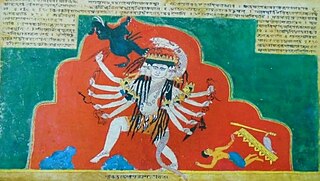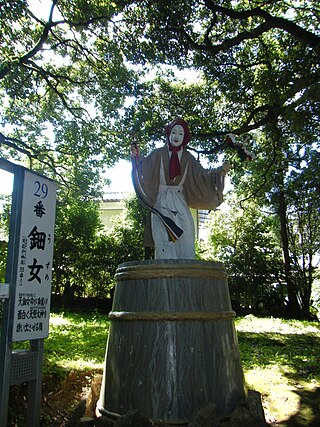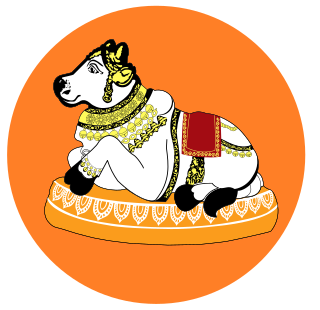Related Research Articles

Zibelthiurdos is a Thracian god of heaven, lightning and rain, whose name is known mainly from epigraphic monuments. The only known reference to this god so far in ancient literature is in Cicero's speech against Pizon, where he is mentioned under the name Jovi Vrii. According to Cicero, Jupiter Urius had the most ancient and venerated of the barbarian temples, which was sacked by invading armies and resulted in diseases from which those afflicted never recovered.

Rudra is a Rigvedic deity associated with Shiva, the wind or storms, Vayu, medicine, and the hunt. One translation of the name is 'the roarer'. In the Rigveda, Rudra is praised as the "mightiest of the mighty". Rudra means "who eradicates problems from their roots". Depending upon the period, the name Rudra can be interpreted as 'the most severe roarer/howler' or 'the most frightening one'. This name appears in the Shiva Sahasranama, and R. K. Sharma notes that it is often used as a name of Shiva in later languages. The "Shri Rudram" hymn from the Yajurveda is dedicated to Rudra and is important in the Shaivite sect. In the Prathama Anuvaka of Namakam, Rudra is revered as Sadasiva and Mahadeva. Sadashiva is the Supreme Being, Paramashiva, in the Siddhanta sect of Shaivism.
Gebeleizis was a god worshiped by the Getae, whose name has been interpreted as a theonym for the Indo-European sky and weather god, evidently also called by the Thracians with a symilar theonym – Zibelthiurdos or Zbelsurdos. In ancient literature he is mentioned only by Herodotus.

Ame-no-Uzume-no-Mikoto is the goddess of dawn, mirth, meditation, revelry and the arts in the Shinto religion of Japan, and the wife of fellow-god Sarutahiko Ōkami. She famously helped draw out the missing sun deity, Amaterasu Omikami, when she had hidden herself in a cave. Her name can also be pronounced as Ama-no-Uzume-no-Mikoto. She is also known as Ōmiyanome-no-Ōkami, an inari kami possibly due to her relationship with her husband. She is also known as Ame-no-Uzume-no-Mikoto, The Great Persuader, and The Heavenly Alarming Female. She is depicted in kyōgen farce as Okame, a woman who revels in her sensuality.

The Nuristanis are an ethnic group native to the Nuristan Province of northeastern Afghanistan and Chitral District of northwestern Pakistan. Their languages comprise the Nuristani branch of Indo-Iranian languages.

Nuristan, also spelled as Nurestan or Nooristan, is one of the 34 provinces of Afghanistan, located in the eastern part of the country. It is divided into seven districts and is Afghanistan's least populous province, with a population of around 167,000. Parun serves as the provincial capital. Nuristan is bordered on the south by Laghman and Kunar provinces, on the north by Badakhshan province, on the west by Panjshir province, and on the east by Pakistan.
The ruki sound law, also known as the ruki rule or iurk rule, is a historical sound change that took place in the satem branches of the Indo-European language family, namely in Balto-Slavic, Armenian, and Indo-Iranian. According to this sound law, an original *s changed to *š after the consonants *r, *k, *g, *gʰ and the semi-vowels *w (*u̯) and *y (*i̯), as well as the syllabic allophones *r̥, *i, and *u:
The Katir are a Nuristani tribe in Afghanistan and Pakistan.

Kalasha is an Indo-Aryan language spoken by the Kalash people, in the Chitral District of Khyber Pakhtunkhwa province of Pakistan. There are an estimated 7,466 speakers of Kalasha accirding to the 2023 Census of Pakistan. It is an endangered language and there is an ongoing language shift to Khowar.
Imra was the chief creator deity of the Nuristani people before their conversion to Islam. Imra was believed to be the creator of the earth. With his breath, it was believed, he created the three other main deities of the pantheon: Mon, Gish and Bagisht.
Gish or Great Gish was the most popular god of Nuristani mythology and received the greatest amount of attention among the Siah-Posh Nuristani of Bashgul. Every village of Bashgul had one or more shrines dedicated to him. In the Nuristani pantheon, Gish ranked next to Moni who was said to be the chief prophet of Imra. Both Moni and Gish were created by Imra by his breath.
"Mlungu dalitsani Malaŵi" is the national anthem of Malawi. It was written and composed by Michael-Fredrick Paul Sauka and adopted in 1964 as a result of a competition.

The Kalash, or Kalasha, are a small Indo-Aryan indigenous (minority) people residing in the Chitral District of the Khyber-Pakhtunkhwa province of Pakistan. The term is also used to refer to several distinct Nuristani speaking people, including the Väi, the Čima-nišei, the Vântä, plus the Ashkun- and Tregami-speakers.
Moni is the second most important god in the pre-Islamic pantheon of the Nuristani people.

The Kalasha Valleys are valleys in Chitral District in northern Pakistan. The valleys are surrounded by the Hindu Kush mountain range. The inhabitants of the valley are the Kalash people, who have a unique culture, language and follow a religion similar to the Historical Vedic religion. There are three main valleys. The largest and most populous valley is Bumburet (Mumuret), reached by a road from Ayun in the Kunar Valley. Rumbur is a side valley north of Bumburet. The third valley, Biriu (Birir), is a side valley of the Kunar Valley south of Bumburet.

A Jyotirlinga or Jyotirlingam is a devotional representation of the Hindu god Shiva. The word is a Sanskrit compound of jyotis ('radiance') and linga ('sign'). The Śiva Mahāpurāṇam mentions 64 original jyotirlinga shrines in India.
Hindu denominations, sampradayas, traditions, movements, and sects are traditions and sub-traditions within Hinduism centered on one or more gods or goddesses, such as Vishnu, Shiva, Shakti and so on. The term sampradaya is used for branches with a particular founder-guru with a particular philosophy.
A theonym is a proper name of a deity.
The Indo-European cosmogony refers to the creation myth of the reconstructed Proto-Indo-European mythology.
Disani was a goddess of the Nuristani people before their conversion to Islam. To the people of Nuristan, she was depicted as living in the terrestrial world, appearing in the shape of a woman with a golden garland. Milk and milk-products were offered to her at the altar on the hillside.
References
- ↑ A Glossary of the Tribes and Castes of the Punjab and North-West Frontier Province: A.-K. Atlantic Publishers & Dist. 1997. ISBN 9788185297699.
- ↑ Halfmann, Jakob. "Nuristani Theonyms in Light of Historical Phonology". In: 6th Indo-European Research Colloquium, 2022. [DOI: http://dx.doi.org/10.13140/RG.2.2.31805.54244]; www.researchgate.net/publication/359109254_Nuristani_Theonyms_in_Light_of_Historical_Phonology